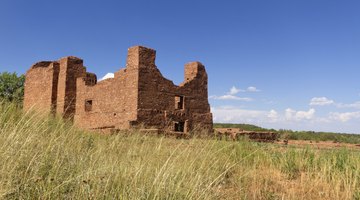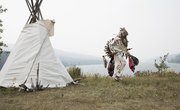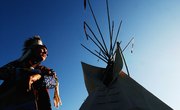The Tigua people are descendants of people who inhabited three separate pueblos in central New Mexico until the beginning of the 17th century. Their tribal headquarters are now located at Ysleta del Sur Pueblo, a federally recognized Indian reservation near El Paso, Texas. The tribe maintains its own political system and police department, and operates Speaking Rock entertainment center. In 2015, the Tigua reservation numbered over 1,600 citizens and 1,500 descendants, according to the tribal website.
Tigua Origins
The original language of the Tigua people is Tiwa, which is also the traditional language of the Isleta, Taos, Sandia and Picuris Pueblos of New Mexico with whom they share roots. Although the origins of the Tigua people aren't completely clear, the Texas State Historical Association reports that scholars believe they originated in Isleta Pueblo south of present-day Albuquerque, and in Quarai, a pueblo to the southeast. The Tigua themselves call three pueblos in central New Mexico their ancestral homeland: Quarai, Abo and Gran Quivera.
Establishment of Ysleta del Sur
When the Spanish first encountered the "Tiguex" -- as they called them -- they were living in villages scattered around Isleta, some of which had more than 200 houses. The Spaniards subsequently conquered them and established a colony in Santa Fe in 1601, but continued Spanish subjugation of traditional practices led to the Pueblo Revolt of 1680, and the Spanish were driven from New Mexico. A group of approximately 317 Tigua were forced to accompany the Spaniards as they retreated to El Paso del Norte, on the banks of the Rio Grande river. There they established Ysleta del Sur -- or Isleta of the South -- Pueblo. When the Spanish regained New Mexico in 1692, some Tigua returned to Isleta and some chose to remain in Ysleta del Sur.
Of Pueblos and Modern Housing
Pueblo tribes -- of which the Tigua are an example -- get their name from the dwellings they build. These multi-story edifices, which were sometimes hewn out of rocks but more often made from a mixture of clay and straw, are composed of individual family units connected to each other by ladders. Unlike wikiups, teepees and other temporary dwellings constructed by Native American tribes, pueblos last for many generations, and some modern tribes still live in them. That isn't true for the Tigua, however. They lost their land in the 1800s and didn't regain full sovereignty until 1987. Most of the contemporary Tigua people live in conventional housing financed by loans from the federal government.
Political Organization
The Tigua employ the tradition political system of the pueblo people. The tribal council elects a cacique, who serves as the religious and cultural leader for life, while a governor, also elected by the tribal council, oversees administrative matters. Traditional pueblo society was matrilineal, which means that homes and land belonged to the mother's family, but at the turn of the 20th century, the Tigua adopted the Hispanic patrilineal system. Through contact with the Spanish, the Tigua also adopted Catholicism, but formal recognition as a tribe in 1968 and regained land sovereignty have led to renewed interest in traditional ways, and modern Tigua ceremonies are often a mixture of Catholic and traditional rituals.
Related Articles
References
Writer Bio
Chris Deziel has a bachelor's degree in physics and a master's degree in humanities. Besides having an abiding interest in popular science, Deziel has been active in the building and home design trades since 1975. As a landscape builder, he helped establish two gardening companies.











